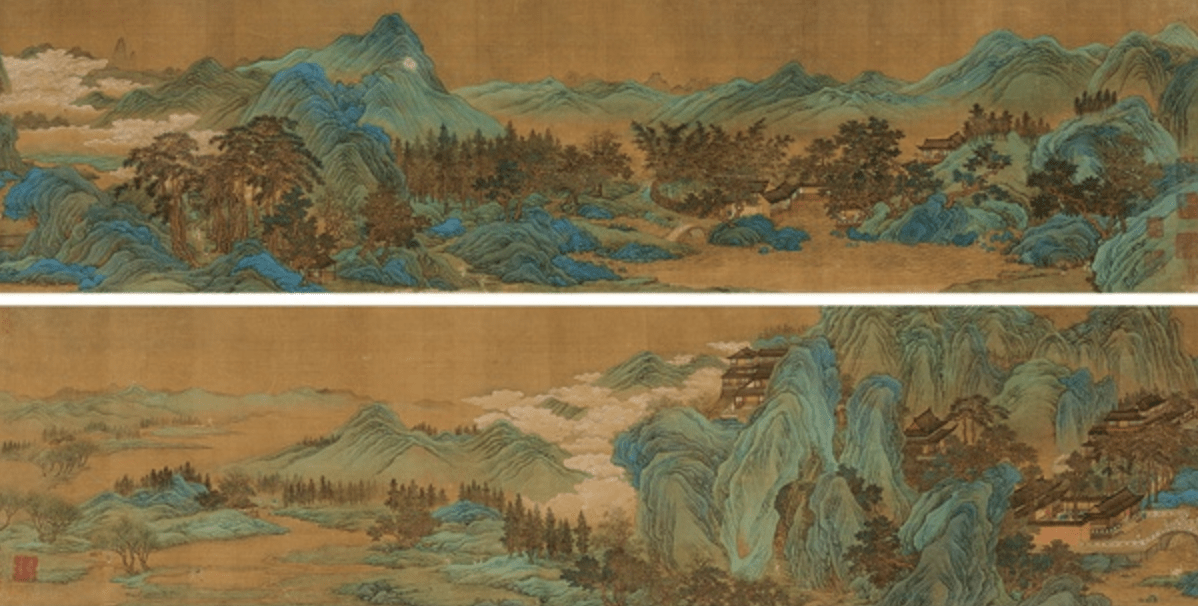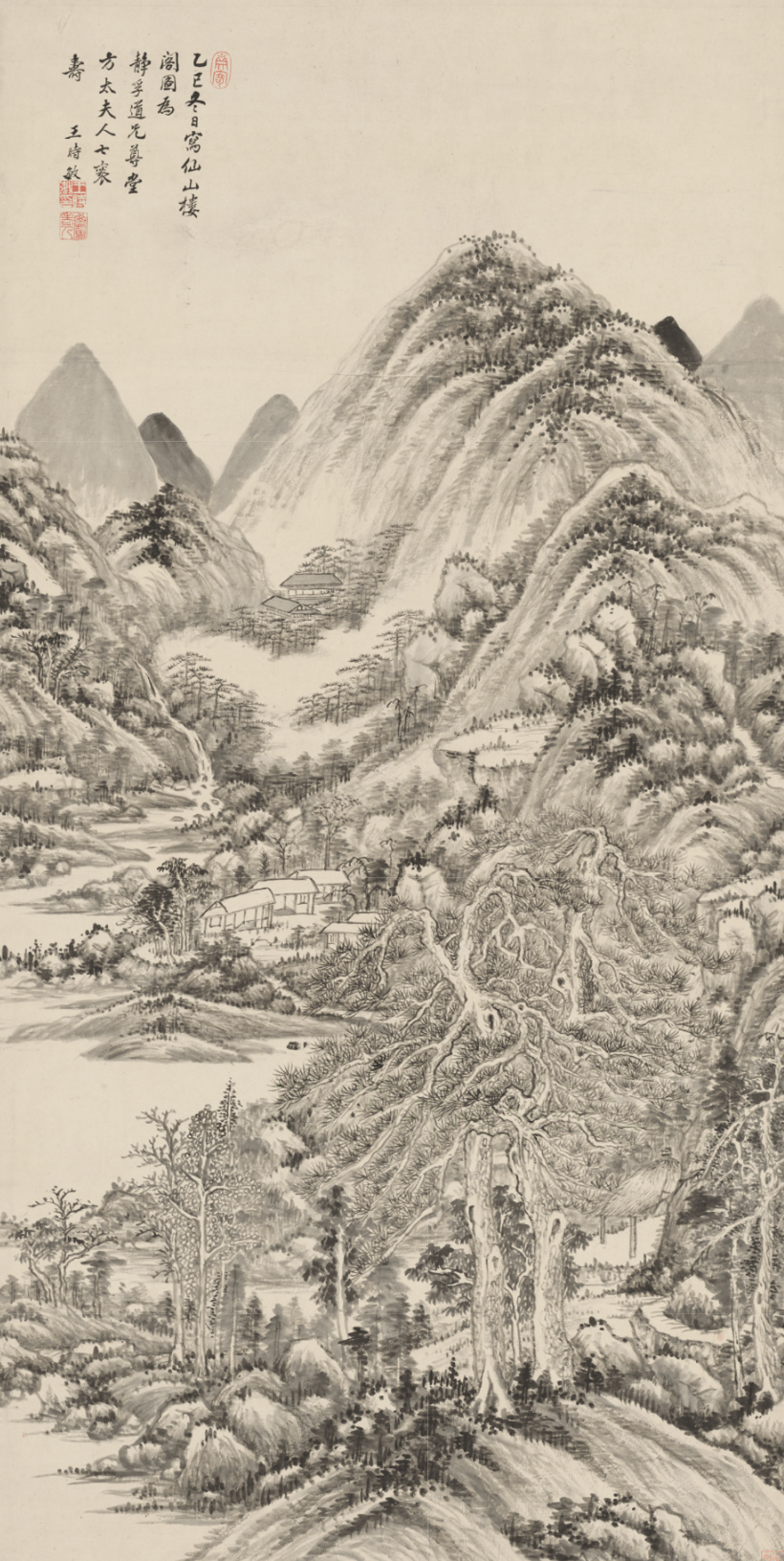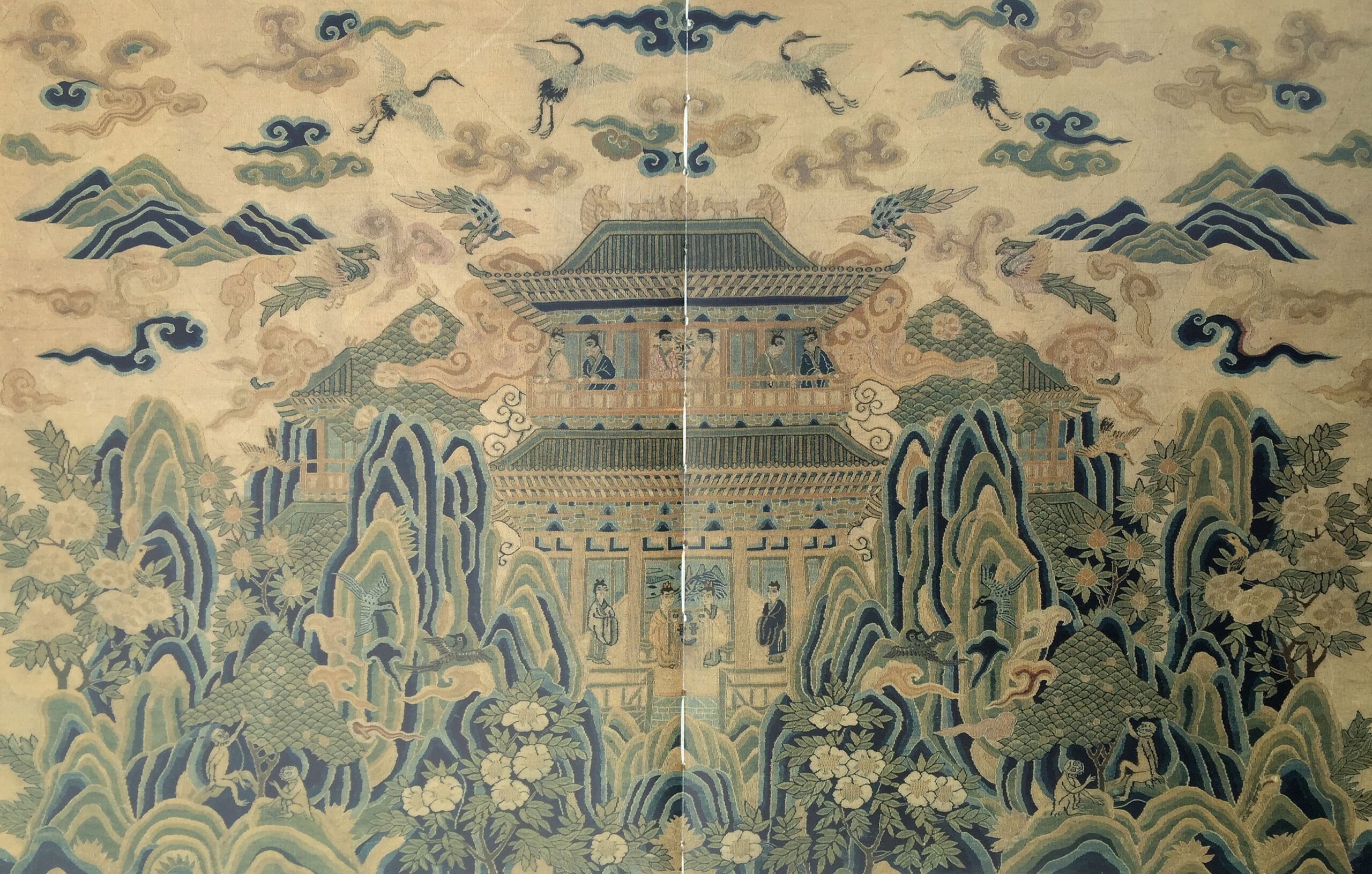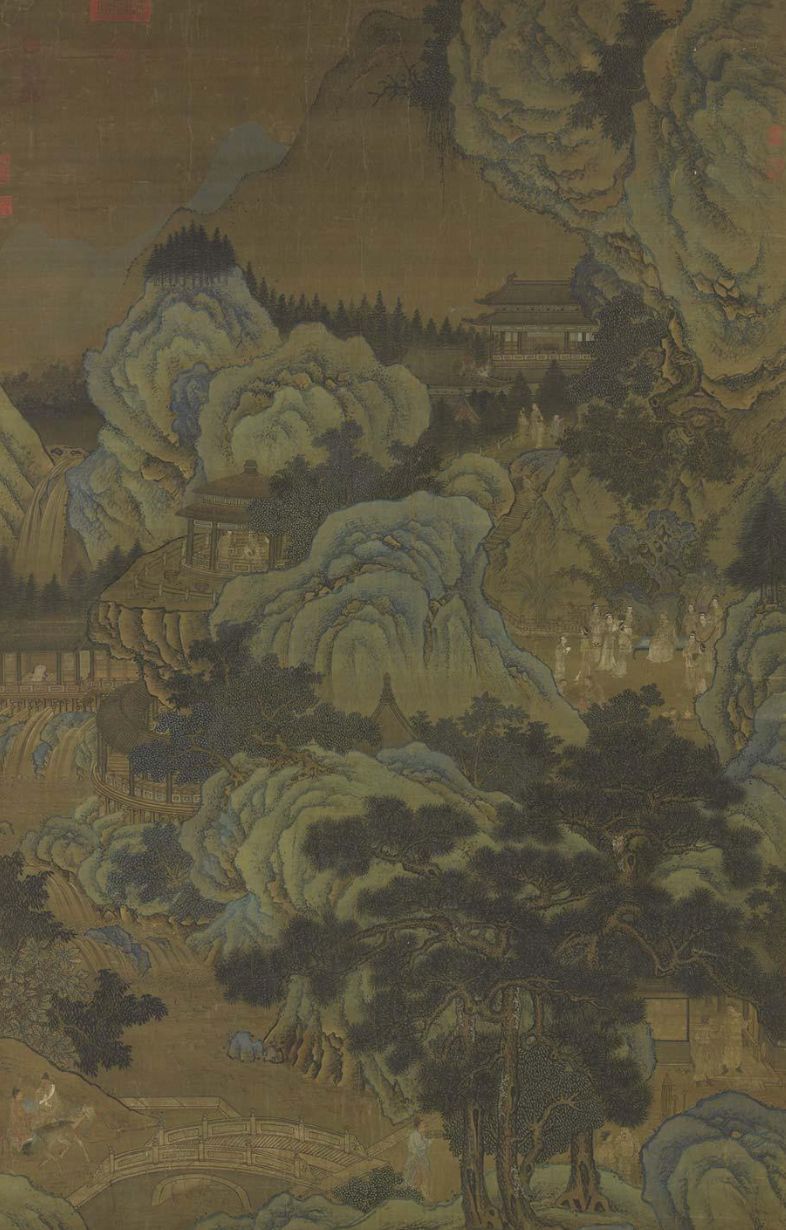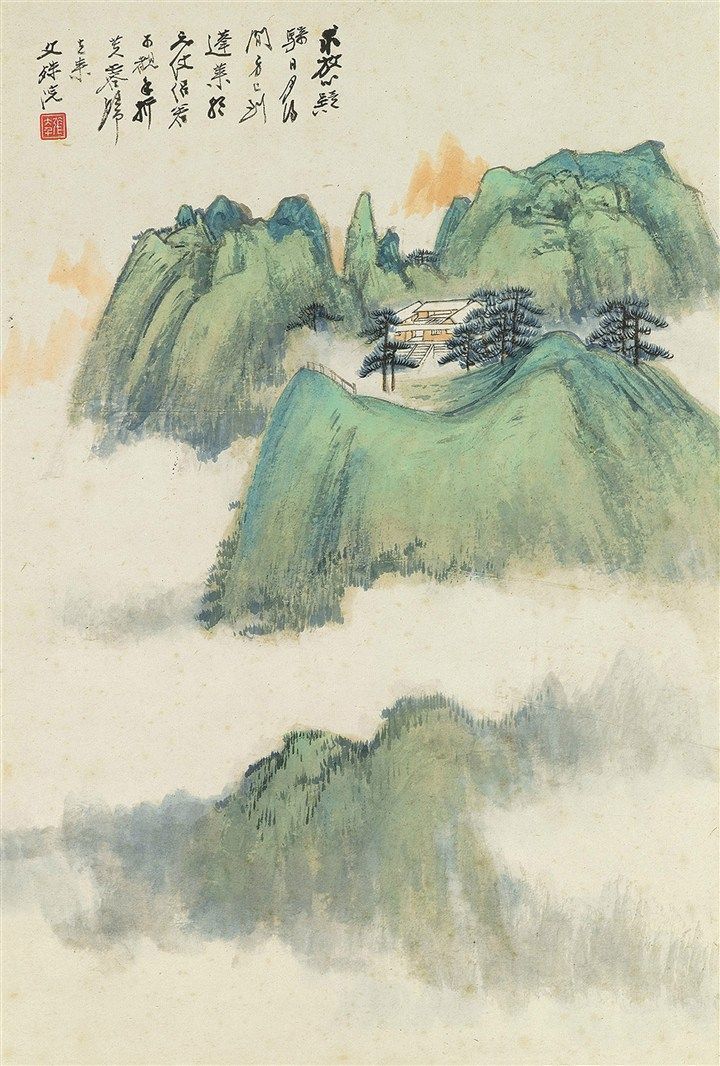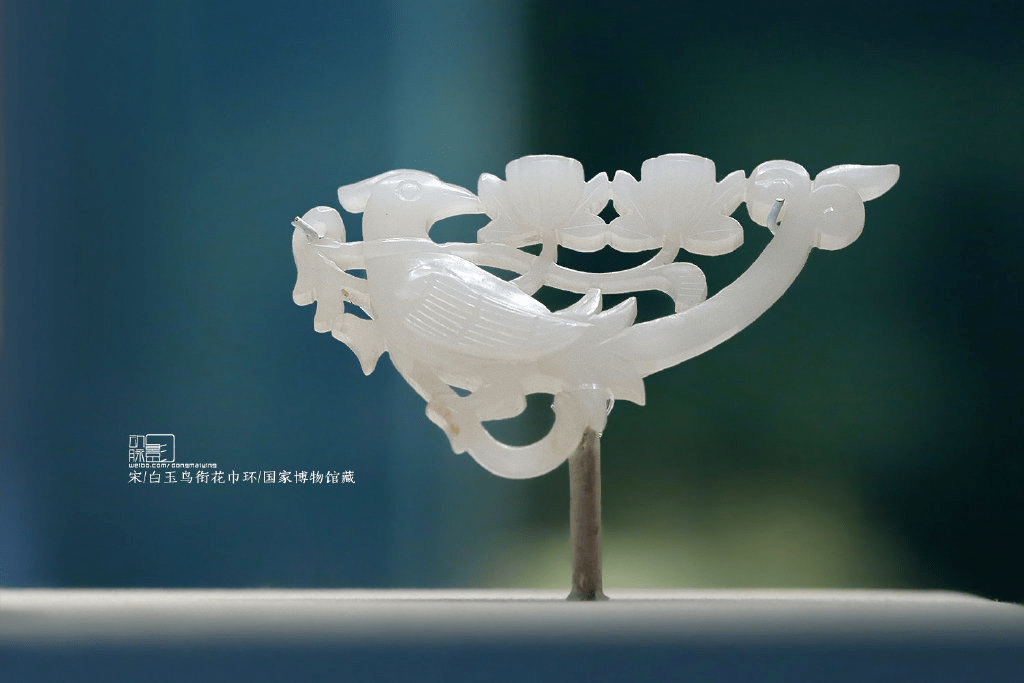Table of Contents
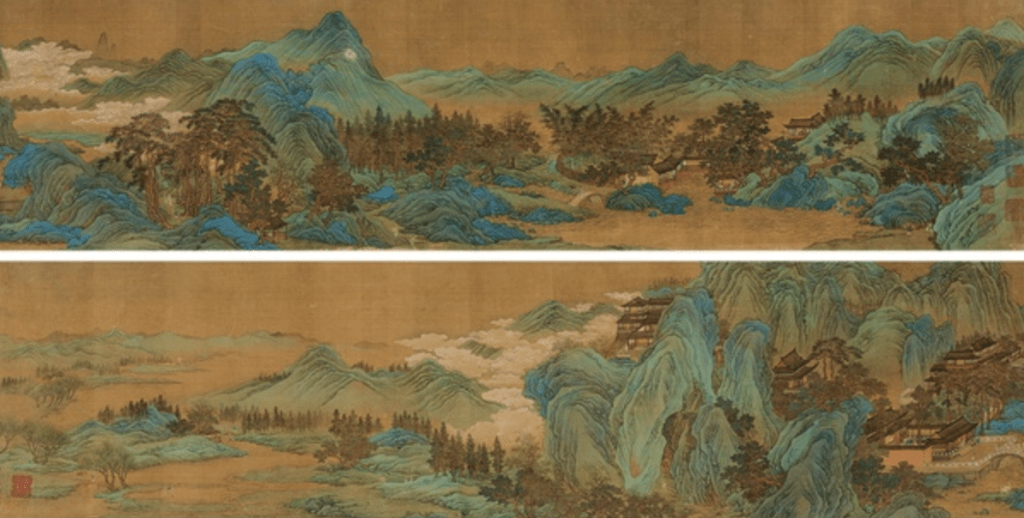
Penglai (蓬萊/蓬莱), also referred to as Peng Lai, Mount Horai, Mount Penglai, or the Island of the Immortals, stands as an enigmatic cornerstone in both Chinese and Japanese mythologies. Shrouded in legend and revered across ancient texts, Penglai remains an enduring symbol of mysticism and eternal allure.
Penglai Island in Mythology
In the annals of Chinese mythology, Penglai emerges as a fabled land, often depicted as an ethereal paradise where the legendary Eight Immortals converge. Nestled within these tales is Mount Penglai, a celestial peak where palaces adorned in gold and silver stand amid an otherworldly landscape where winters never tread, and magical fruits possess the power to heal, bestow eternal youth, and even resurrect the departed.
Across the seas in Japanese mythology, Penglai transforms into Mount Horai, echoing its mystical allure. Here, Xu Fu(徐福), a figure in quest of immortality, and Yang Guifei(杨贵妃), an iconic beauty, find solace and choose to dwell, perpetuating the legend within the cultural fabric of Japan.
Story of Penglai as Described in Liezi
According to Liezi, Penglai is a suspended pavilion above the sea, supported by auspicious clouds. This mythical palace of immortals is described as a breathtaking structure made entirely of gold and jade, where even the birds and beasts are adorned in pristine white.
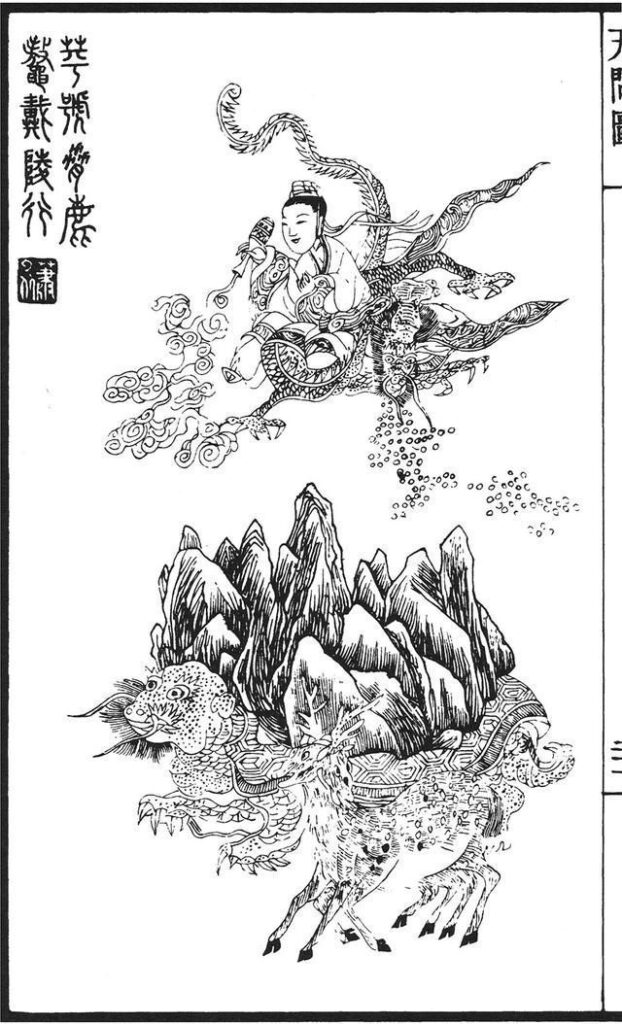
Ao as depicted in XiaoYuncong’s painting, ‘Heavenly Inquiry.’
The foundation of the fairy mountain Penglai is unstable. It ‘constantly follows the ebb and flow of the tide, unable to stay steady for long(常隨潮波上下往還,不得暫峙焉).’
The Heavenly Emperor then orders the sea god to lift the fairy mountain with a giant turtle(Ao). The turtle’s back carries the mountain.
In fact, the sea is home to five fairy mountains, each with its own unique charm. Penglai is one of these majestic mountains, surrounded by a circumference of thirty thousand miles, its towering peak spanning nine thousand miles in breadth. The distances between the peaks extend an impressive seventy thousand miles, making it a seemingly insurmountable altitude for ordinary mortals.
Only immortals can traverse this extraordinary landscape, flying through the sky with ease. However, the foundation of Penglai is not without its challenges; it constantly rises and falls with the tides, never staying fixed. To address this, the Heavenly Emperor commanded the sea god to intervene, using the giant Ao (鰲) to lift the fairy mountain.
Even with Ao’s immense strength, carrying Penglai proved to be a delicate task. In a twist of fate, a giant from the land of Dragon Polity managed to fish away Ao, causing two of the five fairy mountains, Mount Taiyu and Mount Yuanjiao, to sink into the sea.
Amidst the turbulence, only three fairy mountains, including the unsteady Penglai, remained.
The Shape of Mount Penglai
According to WangJia’s ‘Records of the Unearthed Tales《拾遺記》,’ Penglai’s structure, along with two other mystical mountains, Fangzheng and Yingzhou, forms the ‘Three Pots(三壺).’ These mountains symbolize sea-bound wonders—Fanghu(方壺) for Fangzhang(方丈), Ponghu(蓬壺) representing Penglai(蓬萊), and Yinghu(瀛壺) embodying Yingzhou(瀛洲)—all shaped like vessels.
This pot-like representation signifies a contained world, suggesting the possibility of each mountain holding its own unique universe.
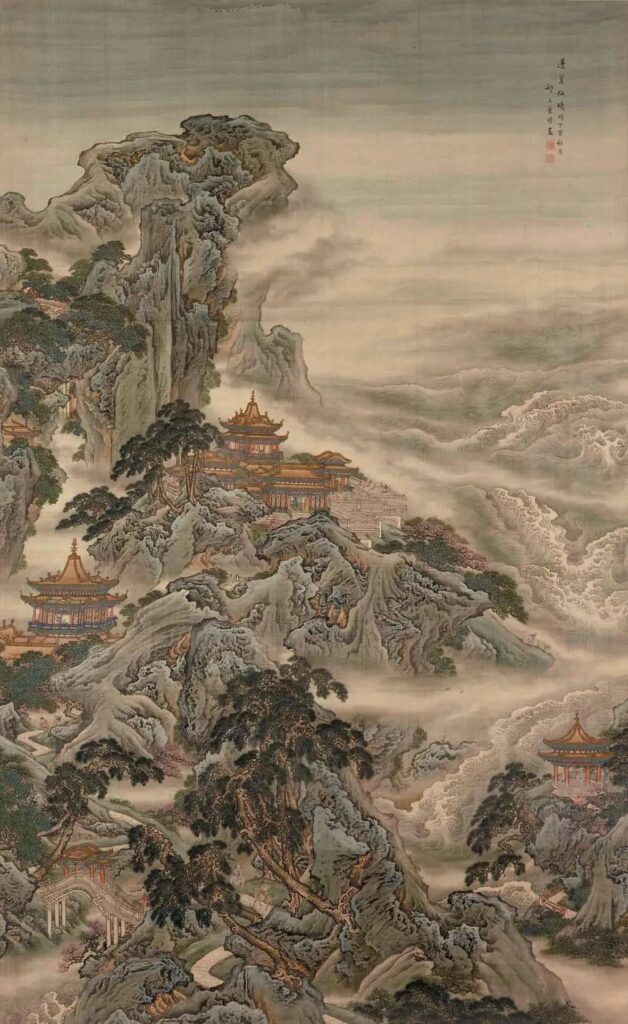
“The Picture of Penglai Wonderland” by Yuan Yao, preserved in the Palace Museum in Beijing. This silk painting, done in colors, measures 266.2 cm in height and 163 cm in width.
The father and son, Yuan, created numerous works depicting the Penglai Wonderland, with Yuan Yao’s rendition being particularly spectacular.
Legends and the Quest for Immortality in Penglai Mythology
The lore surrounding Penglai is steeped in the pursuit of everlasting life. Ancient Chinese narratives recount the endeavors of Qin Shi Huang, China’s first emperor, who tirelessly sought the fabled elixir of immortality, sending emissaries like Xu Fu on journeys that, according to some accounts, led to the discovery of Japan and the christening of Mount Fuji as Penglai.
Da Yu’s visit to Penglai Mountrain
Ancient hero Yu the Great(DaYu), conqueror of floods, reached Penglai after crossing the Weak Water. Offering sacrifices at Bei’ao, he credited Nine Heavens for flood control success. Da Yu toured Five Mountains, instructing craftsmen to carve stone tablets with mountain details in Kochou script.
These tablets, in an ancient script, became the origin of the Chinese mile system we use today.
Qin Shihuang and Xu Fu
It also said in folklore that during the Qin Dynasty, Emperor Qin Shihuang ordered XuFu to lead thousands of boys and girls to search for Penglai and the elixir of immortality.
They failed to find the medicine and never came back, eventually arriving in Japan. It seems the fleet led by Xu Fu run to the new world in the East in dissatisfaction with the Qin Shihuang regime that plundered the people’s fat and built the Great Wall.
Yang Guifei/Yang Yuhuan
In the poem “Chang Hen Ge” written by the Tang Dynasty poet Bai Juyi, after Emperor Xuanzong lost the throne and his beloved Yang Guifei, he experienced profound longing. In desperate love, he sought the help of a Taoist priest to find Yang Guifei’s soul. Ultimately, he found her transformed into the fairy Taizhen on the mystical mountain of Penglai.
Mount Hōrai: A Japanese Perspective on Mount Penglai
In the rich tapestry of Japanese mythology, Mount Penglai finds its counterpart in the legendary Mount Hōrai. While both these mythical places share a common thread, it’s crucial to recognize the unique characteristics that set them apart. In this article, we delve into the Japanese version of Mount Penglai, known as Mount Hōrai, uncovering the distinct narratives and beliefs associated with this sacred mountain.
The Enigmatic Mount Hōrai
Unlike the utopian paradise of Mount Penglai, Mount Hōrai’s narrative is tinged with a nuanced perspective. Japanese myths and legends paint Mount Hōrai as a realm where individuals are granted unparalleled perception and knowledge of ancient souls. However, it’s important to note that Mount Hōrai is not devoid of sorrow or death, and its winters are described as bitterly cold.
The Inhabitants of Hōrai
According to Japanese folklore, Mount Hōrai is inhabited by small fairies characterized by their purity and innocence. These fairies, who possess no knowledge of evil, are believed to maintain hearts untainted by impurities, ensuring they never age. This portrayal adds a unique dimension to the myth of Mount Hōrai, emphasizing the purity of its residents.
Sacred Mountains in Japanese Culture
The reverence for mountains as sacred spaces runs deep in Japanese culture. Mount Fuji, located on Honshu Island, holds a special place in the hearts of the Japanese people. Widely venerated since ancient times, Mount Fuji is considered an Abode of the Immortals by both Buddhist and Shinto faiths. This enduring belief reflects the continued practice of viewing certain mountains as sacred sites where numerous gods reside.
Other Immortal Places Around Penglai Island
The Country of Yuyi Near Mount Penglai
East of Penglai lies the country of Yuyi(郁夷國). In mythology, it is veiled in golden mists. Immortals claim the mountain floats in mist, rising and falling. Buildings on the mountain face the bright direction as mist disperses and all northward when it vanishes. Uncover the enchanting mysteries of Yuyi and its ethereal surroundings.
The Country of Hanming
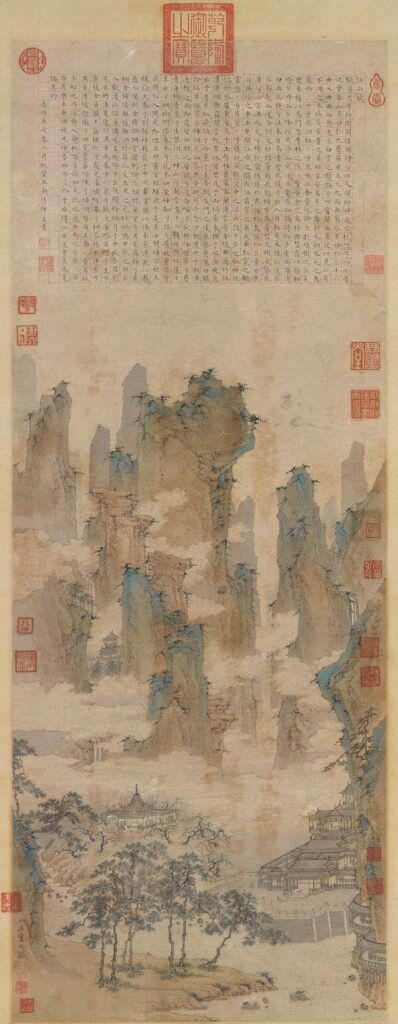
《仙山樓閣圖》 明 仇英
“Immortal Mountain Pavilions” by Qiu Ying, preserved in the National Palace Museum in Taipei
Qiu Ying left behind numerous artworks, and his depiction of Penglai in “Immortal Mountain Pavilions” is a significant representative piece.
In his landscape paintings, Qiu Ying showcases unique scenes of green mountains, white clouds, emerald bamboo, and towering pines, portraying exquisite details with vigorous yet meticulous brushstrokes.
West of Penglai lies Hanming(含明國), a land where people wear bird feathers as clothes and quench thirst with dewdrops. Scaling heights for water, they use stairs of gold, silver, and crystal. The region boasts both icy and hot waters, believed to bestow a thousand years of life to those who partake. Explore the unique lifestyle and extraordinary features of Hanming in this captivating glimpse.
GuiXu
East of the Bohai Sea lies GuiXu(歸墟), an immeasurable, abyssal valley. Waters from diverse sources, including the celestial river, converge without altering volume.
Diverse Interpretations Across Cultures of Penglai Mountain
Across time and cultural landscapes, interpretations of Penglai vary. While some narratives paint a utopian haven where sorrow and death cease to exist, others, like Lafcadio Hearn’s portrayal in “Kwaidan,” imbue Mount Horai with a more nuanced perspective. Here, the atmosphere teems with souls, breathing life into an ethereal realm rich in ancient knowledge.
Penglai stands as an emblem of transcendence, weaving its mystical tapestry across centuries of storytelling. Its portrayal as an island of immortality and celestial beauty resonates through the corridors of both Chinese and Japanese mythologies, encapsulating humanity’s enduring fascination with the allure of the unknown and the pursuit of eternal life.
Penglai Mountain in Chinese Paintings
If mythological novels record the legends of immortals in words, relying on imagination and folk materials, then painters use certain painting subjects, especially landscape paintings, to depict various fantasies in their hearts and dreams, and express various feelings.
《仙山樓閣圖(Immortal Mountain and Pavilion)》仇英
《仙山樓閣圖(Immortal Mountain and Pavilion)》仇英, in the Ming DynastyThe famous painter, QiuYing has another painting of the beautiful scenery of Penglai…
《仙山樓閣圖(Immortal Mountain and Pavilion)》王時敏
《仙山樓閣圖(Immortal Mountain and Pavilion)》王時敏, in the Qing DynastyThis painting was created for the 70th birthday of Chen Jingfu’s mother, shows…
DaYu(夏禹)’s visit in Penglai(蓬萊)
In ancient times, after Yu the Great(DaYu) had controlled the floods, he rode in a carriage across the Weak Water…
About GuiXu(歸墟)
To the east of the Bohai Sea, an unmeasurable distance away, lies a vast, bottomless chasm that is, in reality,…
Penglai in Chinese Folklores
Legends of immortals and immortal realms are widely circulated in Chinese folk culture. Penglai have been widely used to represent fairyland in countless myths.
Below are some of the tales featuring this mythical mountain.
The Grateful Yellow Sparrow
In the land of Hongnong, there lived a kind-hearted man named Yang Bao. At the age of nine, he ventured…
FAQs About Penglai
What is Penglai?
Penglai (蓬萊), also known as Peng Lai or Mount Horai, is a legendary land in Chinese (中国神话/中國神話) and Japanese (日本神話) mythologies. It is often depicted as an otherworldly paradise associated with immortality and mystical attributes.
Where is Penglai?
In mythology, Penglai is typically situated in the Eastern end of the Bohai Sea (渤海) in Chinese lore. However, its exact geographical location remains a subject of debate and various interpretations.
Is Penglai the same as Taiwan island?
No, Penglai is distinct from Taiwan (台灣). While there have been speculations connecting Penglai to different geographical locations, Taiwan is not specifically identified as Penglai in the myths.
How to get to Penglai?
In mythology, reaching Penglai is often portrayed as a challenging or mystical journey. Different texts depict varying methods, such as crossing vast distances of the Weak Water (弱水) or embarking on legendary quests.
What does Penglai look like?
According to myth, Penglai is described as an ethereal paradise where palaces made of gold and silver stand amid landscapes of unparalleled beauty. It’s said to be devoid of agony and winter, with magical fruits and healing properties.
In WangJia(王嘉)’s ‘Records of the Unearthed Tales《拾遺記》’, Penglai ‘s structure is described as resembling a pot, alongside two other mystical mountains, Fangzheng and Yingzhou. These three, collectively termed the ‘Three Pots(三壺) ‘.
Are there real-world locations associated with Penglai?
Some theories propose real-world locations like Penglai in Shandong, China (中国山东蓬莱/中國山東蓬萊), as the departure site for those seeking the mythical island. However, direct connections between these locations and the mythical Penglai remain uncertain.
Is Penglai accessible in modern times?
Penglai is a mythical place, and in contemporary reality, it is not considered an accessible or tangible location. Its existence resides within the realms of ancient legends and cultural narratives.

